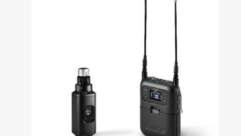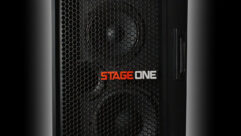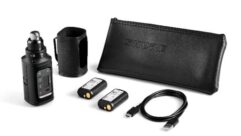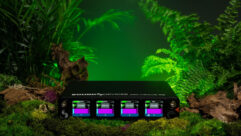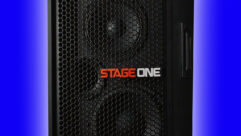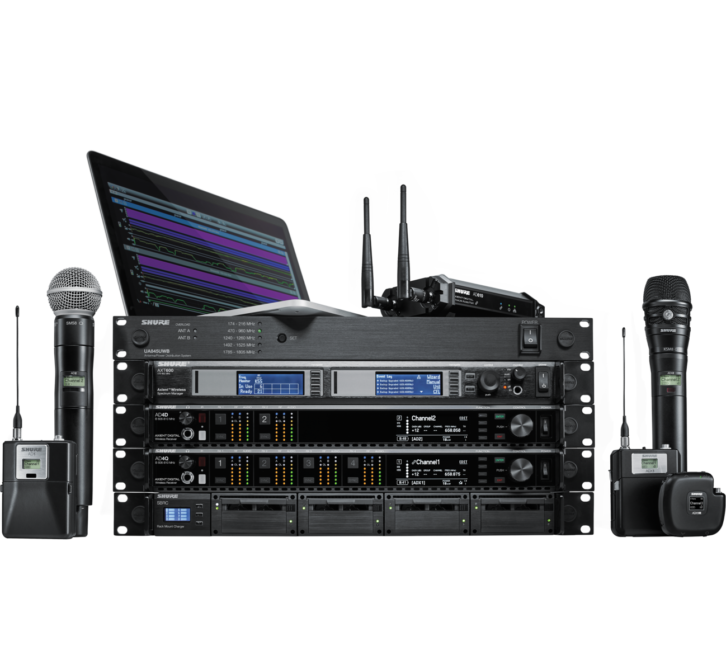
Positioned at the top of the company’s wireless product line, the Shure Axient Digital system was designed for high performance even when used in hostile RF environments. Axient Digital operates in the UHF band, employing True Digital Diversity to protect transmissions from interference by combining two discrete RF signals per receiver channel.
The Axient Digital line includes two receivers, three bodypack transmitters and three handheld transmitters. Mix received the AD4D 2-channel receiver, AD1 bodypack transmitter with instrument cable and an AD2/SM58 handheld transmitter. The AD4 is also available in a 4-channel configuration, and is compatible with Shure ADX transmitters.
The AD4D receiver is built like a tank, so don’t plan on putting it in a flimsy rack. The front panel is laid out very clearly, with a headphone jack and level control, metering and select/sync buttons for each channel, a large display, a set of navigation buttons and a scroll/select encoder.
Rear-panel features include four BNC antenna receptacles, all of which provide DC bias for active antenna. Ports A and B are intended for connection to antenna; ports C and D may be used to cascade RF to another receiver (I found access to these connectors a bit tight for my fingers). Analog audio output is available via XLR (mic or line level) and TRS jacks (fixed at –10 dBV), with ground lift switches per channel. Digital connections include an AES3 port, word clock I/O, two Dante ports and a pair of Ethernet jacks. IEC power I/O connectors complete the set.
The AD1 bodypack is constructed from metal and has a solid feel. A power switch and LED sit between the screw-on antenna port and a TA4 jack for audio input. The LCD’s default screen shows transmitter name, RF setting, Group and Channel numbers, battery gauge and transmission mode. There’s an IR port for sync functions, and underneath the hinged door to the battery compartment are the navigation controls.
As its name suggests the AD2/SM58 handheld transmitter incorporates the Shure SM58 capsule. Users can choose from a variety of Shure capsules, including the Beta 58A and KSM9.
External features include an LCD that provides the same information as that of the AD1, power switch and IR port. The handle unscrews to reveal the battery compartment and a single navigation paddle that toggles in four directions for menu navigation. The AD1 and AD2 may be powered more than eight hours using two AA alkaline batteries or an optional Shure SB900A lithium-ion rechargeable pack; battery life depends to some extent on transmission power level.
SYSTEM FEATURES
As you’d expect from wireless gear in this price range, Axient Digital has tons of features. The tuning range spans 470 to 636 MHz (in the U.S., with the requisite gaps where applicable), providing a wide RF landscape that should be able to accommodate critical situations.
Transmitters can run in Standard or High Density mode. Channel spacing in Standard mode is 350 kHz, allowing transmitters to operate at various power levels without wo
rry of conflict. Standard mode is recommended for situations where plenty of spectrum is available, or when higher transmission power levels are required to increase range.
Channel spacing in High Density mode is 125 kHz, which creates additional available spectrum for increased channel count. Transmission power in HD mode is 2 mW, so HD is better suited to situations requiring shorter range and a high channel count within a limited RF spectrum.
Axient Digital has the ability to run in Frequency Diversity whereby identical audio is transmitted on two separate RF channels simultaneously. In the event that the signal from the active channel degrades, the system seamlessly transfers to the other RF channel, thus maintaining signal quality. Frequency Diversity requires either a splitter cable between the source and two AD1/ADX1 packs, or Shure’s ADX2 FD handheld, frequency diversity transmitter.
ON THE ROAD AGAIN…
I took the Axient Digital system on the road for a period of months across the United States. Getting the system running was easy: power up, push the Control wheel, select a channel and navigate to Channel Scan, at which point you can choose to “Find Best” or “Find Next” channel. I usually started with Find Best.
The scan takes only a few seconds, after which the display shows the best available frequency. Pressing Enter saves the frequency, and pressing Sync on one of the channels transfers the frequency via IR to the AD1 or AD2/SM58 (the IR port on the transmitter must be close to, and facing, the IR port on the AD4D). For all of my trials, transmission power was set to “Normal” (10 mW). I found it difficult to read this setting, as well as some of the other information on the AD1 and AD2/ SM58 LCD screens.
My first use of the Axient Digital system was replacing a 2.4 GHz wireless system in a guitar rig that had a lot of effect pedals and processing. Output level from the AD4D was too hot for the guitar rig, so we engaged the pad (–12 dB) on the AD1. This stopped the AD4D’s
audio meter from clipping, but input to the guitar system was still overloaded. Reducing the AD4D gain –4 to –6 dB restored “unity” with the guitar rig.
The Axient Digital clearly improved the rig’s sound quality and RF performance. Frequency response was more extended at both extremes, but the noise level of the guitar effects made it difficult to judge the Axient Digital’s signal-to-noise ratio. We then moved the AD1 to a different guitar rig where it replaced another 2.4 GHz wireless in a signal chain that went Gibson SG straight into a MESA Boogie Triple ’Rec (no pedals or processing).
The sonic difference between the Axient Digital and the original wireless system bordered on embarrassing—for the other manufacturer. The pure signal chain without effects made it easy to hear that the Axient Digital system blew the old wireless out of the water. Tone and impact of the guitar was restored. It had great dynamics, no RF artifacts and we could now appreciate how quiet the Axient Digital system was. Using the system with the AD2/SM58 produced similar results: the system sounded like a wired 58.
RF performance using either the AD1 or AD2/SM58 was excellent. At soundcheck my techs would walk the stage with instruments or mics, checking for dropouts in the various wireless systems. Not once did they have an issue with the Axient Digital system, even in locales where the other systems struggled. The fact that tuning could reach down to 470 MHz was a definite plus in venues where the 500 MHz regions were already crowded.
The AD4D’s user interface is very easy to grasp, with little or no need for documentation. The Home Screen makes navigation easy, providing a number of options such as viewing all of the info for a single channel or viewing pertinent info such as quality level, battery gauge and frequency for multiple channels simultaneously.
Navigating to view all information for a single channel simply requires pressing that channel’s Select button. Any parameter changed on a transmitter is reflected on the AD4D (provided you are viewing the respective screen), as well as in Shure’s Wireless Workbench software (see sidebar).

A unique feature of Axient Digital receivers is the Channel Quality Meter, a scale from 0 through 5 that displays real-time analysis of RF signal-to-noise ratio. As the RF S/N rat
io drops, fewer segments on the meter illuminate, serving as an early warning for potential problems.
One of many things I liked about the system is its ability to “register” Axient Digital transmitters with the
receiver. If an unregistered Axient Digital transmission appears on the same RF channel as a registered transmitter, the AD4D can block that transmitter and issue a warning. Another manufacturer’s transmitter appearing on the same frequency as a registered transmitter is always blocked. Eight transmitters can be registered per receiver channel, which could come in handy when running multiple guitar packs on the same RF.
When you examine Axient Digital’s feature set combined with its sound quality, it becomes clear that Shure has done a fantastic job. It has extensive RF and audio capabilities that include Dante networking, but it’s easy to get up and running and visit the advanced capabilities as you become familiar with the system.
Shure Wireless Workbench complements the hardware nicely, reflecting changes on-screen and helping manage available spectrum. Given those capabilities and the Axient Digital’s strong showing in both the RF and audio departments, Shure has introduced an excellent product to the high-end wireless market.
PRODUCT SUMMARY
Company: Shure Incorporated
Product: Axient Digital Wireless System
Website: www.shure.com
MSRP: AD4DUS receiver $3,000; AD2/SM58 $889; AD1 $799 ($865 with LEMO connector)
Pros: Excellent RF performance; wide tuning range; great sound; frequency diversity option for critical applications
Cons: Receiver chassis is heavy; expensive; transmitter LCDs are difficult to read


